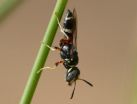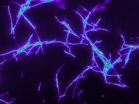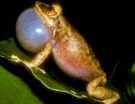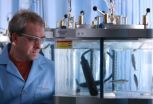(Press-News.org) Like humans, many animals depend on beneficial microbes for survival. Although such symbioses can persist for millions of years, the factors maintaining their long-term stability remain, in most cases, unknown. Scientists from the Max Planck Institute for Chemical Ecology and the University of Regensburg, in collaboration with researchers in the USA, now discovered that certain wasps tightly control mother-to-offspring transmission of their bacterial symbionts. This stabilizes the symbiotic alliance and contributed to its persistence over the past 68-110 million years. (Proceedings of the National Academy of Sciences of the USA, April 2014, DOI: 10.1073/pnas.1400457111)
Symbiotic associations are ubiquitous in nature and play a pivotal role for the ecology and evolution of most organisms on earth. This is exemplified by mykorrhizal fungi that are important nutritional partners for up to 90% of all land plants. Many symbioses have persisted for hundreds of millions of years, with a certain host species consistently associating with a specific symbiont. But how do these alliances persist? After all, many symbionts spend part of their life cycle outside of the host's body. In order to prevent the acquisition of ever-present environmental microbes, the host must discriminate between friends and foes.
A particularly fascinating defensive alliance occurs in the European beewolf (Philanthus triangulum), a digger wasp that hunts honeybees and provisions them for its offspring in underground nests. Previous research has shown that bacterial symbionts of the genus Streptomyces live in the wasp's antennae and on the larval cocoons. The bacteria produce a cocktail of nine different antibiotics that fend off detrimental fungi and bacteria from infecting the developing larva in the cocoon. This strategy to avoid infections is comparable to the combination prophylaxis used in human medicine (see press release of February 23, 2010 ("Beewolves Protect their Offspring With Antibiotics - Digger wasp larvae use bacteria against infections").
The scientists now reconstructed the phylogenies of different beewolf species and their symbionts. An analysis of the beewolf phylogeny revealed that the symbiosis with Streptomyces first originated in the late Cretaceous, between 68 and 110 million years ago. At present, about 170 species of wasps live in symbiosis with the protective bacteria. The comparison of host and symbionts phylogenies yielded another surprising finding: The symbionts of all beewolf species are very closely related, but their phylogeny does not exactly reflect that of their hosts, although this would be expected in case of perfect transmission of symbionts from mother to its progeny. "This pattern indicates that while beewolves occasionally replace their bacteria, they always do so with the symbiont of another beewolf species" explains Martin Kaltenpoth. "Although free-living relatives of the symbiotic bacteria are very common in beewolf habitats, they are apparently not able to stably infect beewolves and replace the native symbionts."
To elucidate how beewolves maintain the association with their specific symbionts, the scientists generated symbiont-free beewolves and then infected them either with their native symbionts or with a related bacterium from the environment. Although both microbes grew in the wasps' antennae, only the native symbiont was successfully transferred to the offspring. "Preventing transmission of other – possibly detrimental – microbes might be important to avoid infection of the cocoon. At the same time, beewolves ensure that their offspring inherit the true defensive symbiont", concludes Erhard Strohm. The beewolves' strategy to transmit the appropriate symbionts provides a unique glimpse into how a symbiosis can remain stable over millions of years, and it helps explain the abundance and persistence of symbiotic associations in insects. In the future, the scientists hope to uncover the molecular basis of how beewolves manage to selectively prevent transmission of non-native bacteria. [MK]
INFORMATION:
Original Publication:
Kaltenpoth, M., Roeser-Mueller, K., Koehler, S., Peterson, A., Nechitaylo, T., Stubblefield, J.W., Herzner, G., Seger, J. & Strohm, E. (2014). Partner choice and fidelity stabilize coevolution in a Cretaceous-age defensive symbiosis. Proceedings of the National Academy of Sciences of the USA. April 2014, DOI: 10.1073/pnas.1400457111
http://dx.doi.org/10.1073/pnas.1400457111
Further Information:
Dr. Martin Kaltenpoth, Max Planck Institute for Chemical Ecology, Hans-Knöll-Str. 8, 07745 Jena, Germany, +49 3641 57-1800, mkaltenpoth@ice.mpg.de
Contact and Picture Requests:
Angela Overmeyer M.A., Max Planck Institute for Chemical Ecology, Hans-Knöll-Str. 8, 07745 Jena, +49 3641 57-2110, overmeyer@ice.mpg.de
Download of high-resolution images via http://www.ice.mpg.de/ext/735.html
Faithful allies since the Cretaceous
Symbiosis between beewolves and their protective bacteria originated millions of years ago
2014-04-14
ELSE PRESS RELEASES FROM THIS DATE:
'Problem wells' source of greenhouse gas at unexpected stage of natural gas production
2014-04-14
WEST LAFAYETTE, Ind. - High levels of the greenhouse gas methane were found above shale gas wells at a production point not thought to be an important emissions source, according to a study jointly led by Purdue and Cornell universities. The findings could have implications for the evaluation of the environmental impacts from natural gas production.
The study, which is one of only a few to use a so-called "top down" approach that measures methane gas levels in the air above wells, identified seven individual well pads with high emission levels and established their stage ...
Penicillin redux: Rearming proven warriors for the 21st century
2014-04-14
Penicillin, one of the scientific marvels of the 20th century, is currently losing a lot of battles it once won against bacterial infections. But scientists at the University of South Carolina have just reported a new approach to restoring its combat effectiveness, even against so-called "superbugs."
Bacteria have been chipping away at the power of the penicillin family of drugs since their first wide-scale use as antibiotics in the 1940s. For example, the staph infection, brought about by the bacterium Staphylococcus aureus, was once readily treated with penicillin and ...
Study links severe sleep apnea to increased risk of stroke, cancer and death
2014-04-14
DARIEN, IL – A new study shows that moderate to severe obstructive sleep apnea is independently associated with an increased risk of stroke, cancer and death.
Results of the 20-year follow-up study show that people with moderate to severe obstructive sleep apnea were four times more likely to die (hazard ratio = 4.2), nearly four times more likely to have a stroke (HR = 3.7), three times more likely to die from cancer (HR = 3.4), and 2.5 times more likely to develop cancer. Results were adjusted for potential confounding factors such as body mass index, smoking status, ...
Shared decision making during radiation therapy improves patient satisfaction
2014-04-14
PHILADELPHIA—Playing an active role in their radiation treatment decisions leaves cancer patients feeling more satisfied with their care, and may even relieve psychological distress around the experience, researchers from the Perelman School of Medicine at the University of Pennsylvania report in the journal Cancer.
In a study of 305 patients undergoing radiation treatment, Neha Vapiwala, MD, an associate professor in the department in Radiation Oncology at Penn Medicine, and colleagues at link "Penn's...Center: Penn's Abramson Cancer Center found an association between ...
Plague alters cell death to kill host
2014-04-14
Northwestern Medicine scientists are continuing to unravel the molecular changes that underlie one of the world's deadliest and most infamous respiratory infections.
When the bacterium Yersinia pestis enters the lungs, it causes pneumonic plague, a disease that is 100 percent fatal if untreated. The way in which Y. pestis evades the immune system and kills people in a matter of days has largely confounded scientists, until now.
Following a 2007 study demonstrating that the presence of a protein called the plasminogen activator protease (Pla) is required for Y. pestis ...
Climate change a likely culprit in coqui frog's altered calls, say UCLA biologists
2014-04-14
Changes in the Puerto Rican climate over the past three decades have caused small but significant changes to the coqui frog, the territory's national animal. UCLA biologists have found that not only have male coquis become smaller, but their mating call has also become shorter and higher pitched.
Authored by Peter Narins, UCLA distinguished professor of integrative biology and physiology and of ecology and evolutionary biology, and Sebastiaan Meenderink, a UCLA physics researcher, the study examined 170 male coqui frogs (Eleutherodactylus coqui) in 1983 and then 116 ...
Making dams safer for fish around the world
2014-04-14
RICHLAND, Wash. – Think of the pressure change you feel when an elevator zips you up multiple floors in a tall building. Imagine how you'd feel if that elevator carried you all the way up to the top of Mt. Everest – in the blink of an eye.
That's similar to what many fish experience when they travel through the turbulent waters near a dam. For some, the change in pressure is simply too big, too fast, and they die or are seriously injured.
In an article in the March issue of the journal Fisheries, ecologists from the Department of Energy's Pacific Northwest National ...
Cosmic slurp
2014-04-14
Somewhere in the cosmos an ordinary galaxy spins, seemingly at slumber. Then all of a sudden, WHAM! A flash of light explodes from the galaxy's center. A star orbiting too close to the event horizon of the galaxy's central supermassive black hole is torn apart by the force of gravity, heating up its gas and sending out a beacon to the far reaches of the universe.
In a universe with tens of billions of galaxies, how would we see it? What would such a beacon look like? How would we distinguish it from other bright, monumental intergalactic events, like supernovas?
"Black ...
Researchers identify children with emotional behavior difficulties
2014-04-14
Research on children orphaned by HIV/AIDS in South Africa may provide insight on how to identify and help children with emotional behavior issues in other areas of the world, which may have limited access to healthcare and further research that could lead to successful interventions.
A report on the global AIDS epidemic published by the United Nations mentions that due to the HIV/AIDS pandemic, which has left 12 million children orphaned in Sub-Saharan African, children are at an increased risk for mental health problems.
"There has been a big push to understand what ...
Henry Ford Hospital hits new heart valve surgery milestone
2014-04-14
DETROIT – Doctors at Henry Ford Hospital reached a medical milestone April 3, performing the 25th successful transcatheter valve replacement using a novel way to access the heart.
Henry Ford is the only hospital in the United States performing the unique procedure called transcaval valve replacement, which accesses the heart by temporarily connecting major blood vessels.
Northern Michigan resident Viola Waller, 80, underwent Henry Ford's first transcaval procedure on July 3, 2013 when traditional valve replacement was not medically viable.
"Nobody could help me here," ...
LAST 30 PRESS RELEASES:
Beech trees use seasonal soil moisture to optimize water uptake
How thinning benefits growth for all trees
Researchers upgrades 3-PG forest model for improved accuracy
Achieving anti-thermal-quenching in Tb3+-doped glass scintillators via dual-channel thermally enhanced energy transfer
Liquid metal modified hexagonal boron nitride flakes for efficient electromagnetic wave absorption and thermal management
Failure mechanisms in PEM water electrolyzers
Study captures how cancer cells hide from brain immune cells, shows that removing their “don’t eat me” signals stops their escape
New breakthrough in detecting ‘ghost particles’ from the Sun
Half of people arrested in London may have undiagnosed ADHD, study finds
From dots to lines: new database catalogs human gene types using ’ACTG’ rules
Persistent antibiotic resistance of cholera-causing bacteria in Africa revealed from a multinational workshop for strengthening disease surveillance
SwRI, Trinity University to synthesize novel compound to mitigate effects of stroke, heart attack
Novel endocrine therapy giredestrant improves disease-free survival over standard of care for patients with early-stage breast cancer in phase III lidERA trial
Gen Z views world as "scary place" with growing cynicism about ability to create change
Biosensor performance doubled – New applications possible
Leveraging incomplete remote sensing for forest inventory
Key chemical in dark chocolate may slow down ageing
New 15-minute hepatitis C test paves the way for same-day treatment
Uranus and Neptune might be rock giants
Magnetically actuated soft electrodes for multisite bioelectrical monitoring of ex vivo tissues
FAU engineers decode dementia type using AI and EEG brainwave analysis
Carrier-free peptide–daunorubicin–small interfering RNA nanoassembly for targeted therapy of acute myeloid leukemia
Global Virus Network announces appointment of new board members
Artificial beaver dams show promise in offsetting climate change effects
Could hidden infections be fueling long COVID?
Targeted oxygen for initial resuscitation of preterm infants
Researchers develop models to help diagnose ALS earlier through blood biomarkers
Jeonbuk National University researchers develop novel eco-friendly and photo-switchable smart adhesives
Magnetic ordering induces Jahn–Teller effect in spinel-type compounds
A mitochondrial protein may hold the secret to longevity, new study finds
[Press-News.org] Faithful allies since the CretaceousSymbiosis between beewolves and their protective bacteria originated millions of years ago









